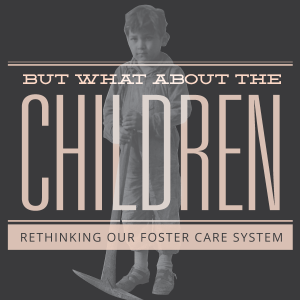What About the Children? Rethinking Our Foster Care System
Not Just Another Number:
● 400,540 children in the US are without permanent homes and families
○ 115,000 are eligible to be adopted
○ Almost 40% will be in foster care for more than 3 years before adoption
● The number of children in foster care has dropped significantly in recent years
○ 2002: 523,616
○ 2012: 399,546
○ Drop of 23.7%
● Of all races, African American children saw the sharpest decline (47% between 2002 – 2012)
○ Made up 74% of all foster care decline
Number of Children in foster care licensing process on September 30 by race/ethnicity*
Black or African American: Percent change: -47.1%
White: Percent change: -17.7%
Hispanic: Percent change: -2.5%
American Indian / Alaska Native: Percent change: -14.3%
Asian: Percent change: -33.3%
Native Hawaiian / Other Pacific Islander: Percent change: -33.9%
Two or More: Percent change: -47.1%
Missing or Unable to Determine: Percent change: -9.4%
● 2002 – 2012: only ten states made up 90% of total decline in foster care
○ 3 states, CA, NY and FL, made up 50%
● ¼ of states showed an increase
● Children stay an average of 22.4 months in foster care
○ Down from 31.3 months since 2002
Dangers Facing Orphaned Children
● 2011: almost 60k children were taking from foster care and placed in institutions or group homes
● Children 3 and under should never be institutionalized
○ These children need a primary caregiver to nurture their development
○ They can suffer from disorders like:
■ attachment disorder, developmental delay, neural atrophy
● According to 75 different studies (almost 4k children in 19 countries)
○ Orphans raised in an institution score 20 points lower on IQ tests than their peers in child care
○ Indicates a strong need for family vs. institution
● 27k children “age out” of foster care annually
○ They lack financial and emotional support for success
○ Nearly 40% experience homelessness
○ Nearly 60% of young males are convicted of crime
○ Only 48% are employed
○ 75% of females and 33% of males receive government help for basic needs
○ 50% of those who age out have been been involved with substance abuse
○ 17% of females are pregnant
○ Nearly 25% of those who “age out” do not have a high school diploma or GED
■ Only 6% have finished any college after foster care
■ 70% show a desire to attend college
● 3 out of 10 of homeless adults report having been in foster care as children
● On average, 63% of former foster children earn minimum wage
What Can We Do to Make a Difference?
● Needed changes:
○ Less time spent institutions or group homes
○ More time spent with competent foster parents
○ More support for young adults leaving foster care
● How to make an impact:
○ Strengthen impoverished communities
■ Most foster children come from poverty
○ Build community safety nets for protecting children
○ Strengthen original families
○Try fostering, for this you’ll need to start a foster care licensing process
○ Case workers need better support
■ Better training, development and nurturing
○ Educate the public
■ The public must be made aware of the intricacies and complications of foster care
○ Better psychological help for abused children
■ Unresolved issues like grief, loss, trauma from abuse affects a child’s mental stability
■ Teach orphaned children how to build healthy relationships
Sources:
http://www.acf.hhs.gov/sites/default/files/cb/data_brief_foster_care_trends1.pdf
http://www.ccainstitute.org/index.php?option=com_content&view=category&layout=blog&id=25&Itemid=43
http://www.cwla.org/programs/housing/youthfostercarestats.htm#note4
http://www.childrensrights.org/issues-resources/foster-care/facts-about-foster-care/
http://abcnews.go.com/Primetime/story?id=132011
http://www.socialworktoday.com/archive/031109p30.shtml


